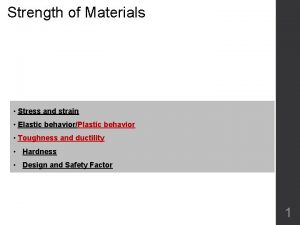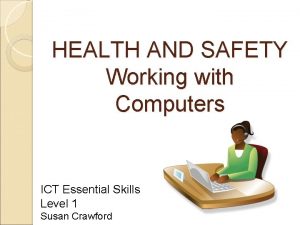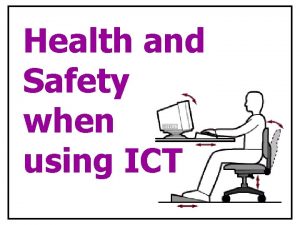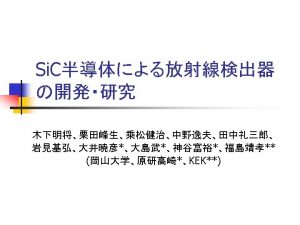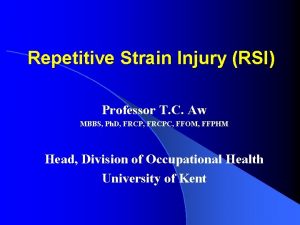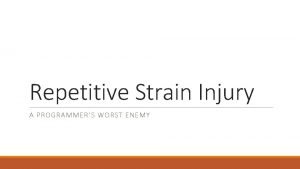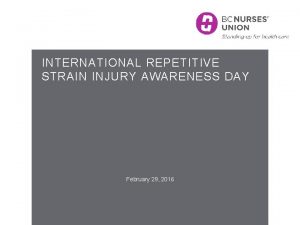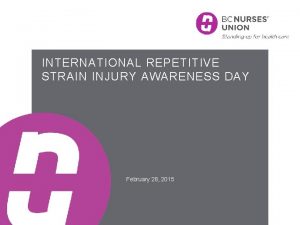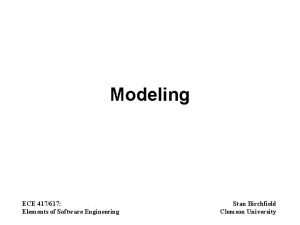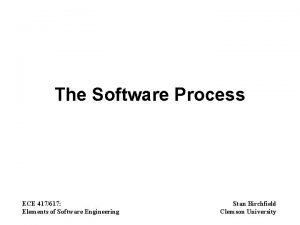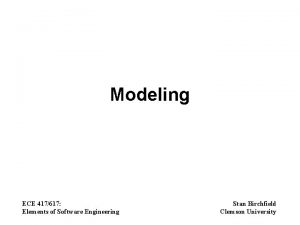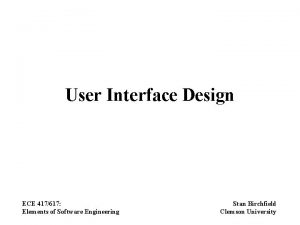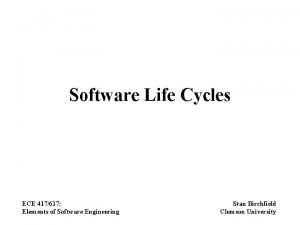Repetitive Strain Injury RSI ECE 417617 Elements of



![The cost of RSI • $20 billion per year [Information Week, Nov. 9, 1992] The cost of RSI • $20 billion per year [Information Week, Nov. 9, 1992]](https://slidetodoc.com/presentation_image_h/e42ce41e2f71bdefbca2878affe48e0e/image-4.jpg)











- Slides: 15

Repetitive Strain Injury (RSI) ECE 417/617: Elements of Software Engineering Stan Birchfield Clemson University

You are a computer athlete A dangerous occupation: This is also dangerous: As a typical computer user, you “walk” several miles each day on your fingertips (250 keystrokes / min) * (2 in / keystroke) * 4 hours = 2 miles

What is RSI? • Repetitive Strain Injury (RSI) – is pain or nerve problems in upper extremity (hands, arms, or shoulders) – can also include neck and back – is a soft tissue disease (muscles and nerves) – is an overuse syndrome • Symptoms: – burning, numbness, tingling, pins-and-needles – dull aching OR specific, intense pain • Controversial: – many deny it exists – sufferers receive little support from employers
![The cost of RSI 20 billion per year Information Week Nov 9 1992 The cost of RSI • $20 billion per year [Information Week, Nov. 9, 1992]](https://slidetodoc.com/presentation_image_h/e42ce41e2f71bdefbca2878affe48e0e/image-4.jpg)
The cost of RSI • $20 billion per year [Information Week, Nov. 9, 1992] • $29, 000 average compensation • accounts for 60% of all job-related injuries [Department of Labor] • Approx. ¾ of all jobs require using a computer

Carpal tunnel syndrome • Carpal Tunnel Syndrome is a specific type of RSI • Swelling increases pressure on nerves to fingers • Problem is only in wrist • Most RSI is more widespread (neck, back, arms, shoulders)

What causes RSI?

Cantilevers stress

Bad posture pronation slouching ulnar deviation dorsiflexion

Anatomy of hand nerves Thoracic outlet: • b/w collarbone and rib #1 Brachial plexus: • braided nerves • also supplies shouder, neck, and arm muscles bottom view top view brachial plexus Three nerves: • Median through carpal tunnel • Ulnar “funny bone” • Radial extensor muscles

Traditional solutions • • • Surgery Wrist braces Anti-inflammatory drugs Pain killers Cortisone shots Ergonomic keyboard, mouse, etc. Why should you be cautious?

Keep in mind • Long-term problem long-term solution • The pain may move • The pain may go away temporarily, even though the problem is not solved • Musculoskeletal system (muscles, tendons, and bones) adapts • Body is meant to move – Ergonomics are important, but beware of trying to achieve “perfect posture”

Outline of a solution 1. Stretching 2. Movement 3. Strength Also posture, massage, remove wallet from back pocket, hot/cold treatment, ergonomic keyboard / mouse, better chair, . . .

Computer vision syndrome (CVS) • Computer screens are different from printed material – Contrast is not sharp – Edges of characters are not well-defined • Our eyes have difficulty focusing – Instead, eyes drift to the resting point of accommodation (RPA) – Eyes involuntarily move to RPA, then strain to regain focus • Results – Fatigue, tired eyes from continuous flexing – Dry eyes from not blinking enough

Final advice • You think RSI will never happen to you • When you start feeling pain, you will – ignore it – learn to bear it – expect it to go away on its own • When your pain disappears temporarily, you will think problem is solved • When your pain intensifies gradually, you will continue to ignore it until it is serious Pain is your body’s way of telling you that something is wrong! Be aware! Do not ignore the symptoms! Seek help when the pain first appears, before it becomes a serious problem!

For further reading • Damany and Bellis, It’s Not Carpal Tunnel Syndrome! • Pascarelli, Repetitive Strain Injury
 Examples of intentional injury
Examples of intentional injury Strain injury
Strain injury Elastic strain and plastic strain
Elastic strain and plastic strain Compliance and stiffness
Compliance and stiffness Srx idp configuration
Srx idp configuration Rsi security camera
Rsi security camera Rsi ravenna
Rsi ravenna Rsi
Rsi Rsi medication order
Rsi medication order Health and safety on computers
Health and safety on computers Rsi vs dsi
Rsi vs dsi Ict health and safety worksheet
Ict health and safety worksheet Ctfg rsi
Ctfg rsi Hsi rsi
Hsi rsi Rsi reference safety information
Rsi reference safety information Maio fascia release
Maio fascia release


